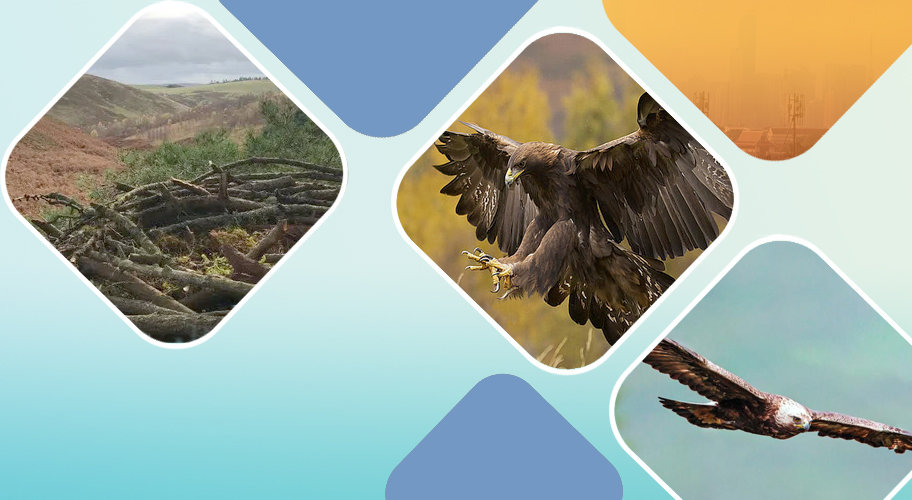Artificial eyries raise hopes of golden eagles breeding in southern Scotland
Nests placed close to where three young birds have been spotted with intention of encouraging them to reproduce.
Two artificial eyries have been placed high in the trees on a private estate in southern Scotland to encourage translocated golden eagles to breed in the region.
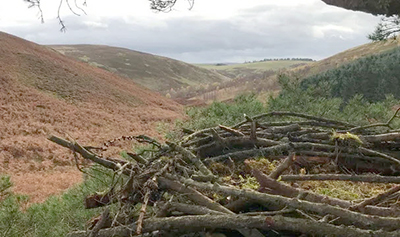
Expert climbers erected the huge nests in hard-to-reach locations on the Duke of Northumberland’s Burncastle estate, close to where three young satellite-tagged golden eagles have been spotted.
The artificial nests are the first to be placed on private land, with more than 17 privately owned estates including shooting estates with grouse moors supporting the South of Scotland Golden Eagle project.
A series of translocations have increased the area’s population from a few pairs to 38, the highest number recorded for three centuries. The nests are designed to encourage the eagles to establish territories and breed in the coming years.
The chair of the project, Michael Clarke, said: “We are delighted to see so many estates supporting the South of Scotland Golden Eagle project and recognizing the importance of this iconic species. As a top predator, golden eagles help to maintain healthy ecosystems. They support the survival and prosperity of all healthy prey species, and are brilliant for ecotourism, too.”
The Duke of Northumberland said he was thrilled that golden eagles had re-established themselves in southern Scotland.
“It has been exciting to see these magnificent birds occupy a range close to Burncastle,” he said. “The estate was very keen to play a part in helping the birds, and the opportunity to build the eyries on Burncastle will hopefully raise the prospects of new chicks being born in the future.”
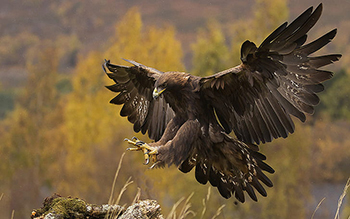
Illegal persecution has brought the golden eagle to virtual extinction outside its Highlands stronghold. There were between two and four pairs of golden eagles across Dumfries and Galloway and the Scottish Borders before the project began in 2018. Scientists calculate there is habitat suitable for 16 pairs.
According to the project’s manager, Dr Cat Barlow, estates including grouse moors have been keen to join the project because the eagles help to manage predators.
“In the absence of golden eagles, predator species such as crows and foxes and even buzzards are probably at slightly abnormal levels. Having golden eagles around on an estate might balance things out a little bit.
“Estates also want to demonstrate what they are doing for biodiversity and are keen to show that the history of persecution is in the past now. Having a pair of golden eagles is quite a visible way to doing that.”
The project has successfully moved 18 juvenile golden eagles from the Highlands to the south of Scotland alongside seven young adult birds between six months and three years old. One tagged bird was found dead in February of currently unknown causes, but Barlow said the survival rates of the translocated birds had been “absolutely astounding”.
Some of the translocated birds have visited the Pennines and Northumberland, and it is hoped that a successful population could spill over into northern England and the Lake District. England’s last resident golden eagle disappeared in 2015.
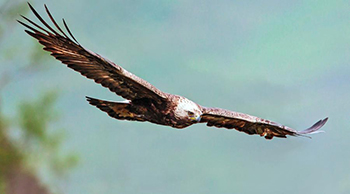
The new eyries are close to where two 18-month-old females and one male have been spotted in Burncastle and the western Lammermuirs. Older birds first released by the project in 2018 could also establish territories in the area and use the nests. Golden eagles typically begin to breed at three or four years old.
Ross Ewing, the moorland director at Scottish Land & Estates, said: “The role of private estates, many of which have grouse shooting interests, in supporting the South of Scotland Golden Eagle project has been pivotal in many ways, including the provision of 90% of the eagle chicks translocated from north to south.”
รังนกอินทรีเทียมเพิ่มความหวังในการผสมพันธุ์อินทรีทองคําทางตอนใต้ของ สกอตแลนด์
รังเทียมนี้ถูกวางไว้ใกล้กับจุดที่พบเห็นลูกนกสามตัวด้วยความตั้งใจที่จะส่งเสริมให้พวกมัน สืบพันธุ์
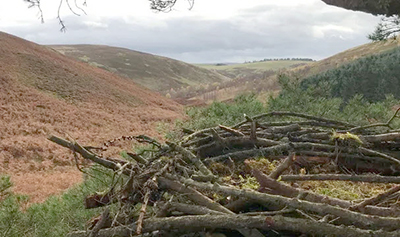
มีการวางรังนกอินทรีทียมสองรังไว้บนต้นไม้บนที่ดินส่วนบุคคลทางตอนใต้ของสกอตแลนด์เพื่อส่งเสริมให้นกอินทรีทองคําที่ย้ายถิ่นฐานไปแล้วกลับมาผสมพันธุ์ในภูมิภาคนี้
นักปีนเขาผู้เชี่ยวชาญสร้างรังขนาดใหญ่ในสถานที่ที่เข้าถึงยากบนที่ดิน Burncastle ของ Duke of Northumberland ใกล้กับจุดที่พบนกอินทรีทองคําที่ติดแท็กจากดาวเทียมสามตัว
รังเทียมเป็นรังแรกที่วางบนที่ดินส่วนตัวโดยมีที่ดินของเอกชนมากกว่า 17 แห่งรวมถึงที่ดินที่มีทุ่งเลี้ยงสัตว์สนับสนุนโครงการ South of Scotland Golden Eagle
จํานวนการเคลื่อนย้ายได้เพิ่มจํานวนประชากรในพื้นที่จากสองสามคู่เป็น 38 คู่ ซึ่งเป็นจํานวนสูงสุดที่บันทึกไว้เป็นเวลาสามศตวรรษ รังถูกออกแบบมาเพื่อส่งเสริมให้นกอินทรีสร้างดินแดนและผสมพันธุ์ในอีกไม่กี่ปีข้างหน้า
การล่าอย่างผิดกฎหมายทําให้อินทรีทองคําเสมือนสูญพันธุ์ไปแล้วบริเวณนอกฐานที่มั่นของมันที่เป็นที่ราบสูง มีอินทรีทองคําgเพียงสองถึงสี่คู่ทั่ว Drumfries และ Galloway และพรมแดนสกอตแลนด์ก่อนที่โครงการจะเริ่มขึ้นในปี 2018 นักวิทยาศาสตร์คํานวณว่ามีที่อยู่อาศัยที่เหมาะสมสําหรับ 16 คู่
ดร.แคท บาร์โลว์ ผู้จัดการโครงการกล่าวว่า ที่ดินรวมถึงทุ่งเลี้ยงสัตว์มีความกระตือรือร้นที่จะเข้าร่วมโครงการเพราะนกอินทรีช่วยจัดการนักล่า
“ในกรณีที่ไม่มีอินทรีทองคํา สายพันธุ์นักล่า เช่น อีกาและสุนัขจิ้งจอก และแม้แต่นกกระจอกอาจอยู่ในระดับที่สูงผิดปกติเล็กน้อย การมีอินทรีทองอยู่รอบๆ บนที่ดินอาจทําให้สิ่งต่างๆ สมดุลกันมากขึ้น
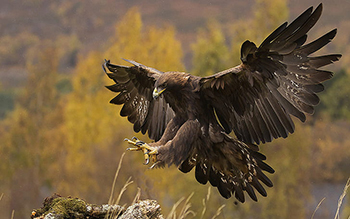
“เจ้าของที่ดินต้องการแสดงให้เห็นว่าพวกเขากําลังทําอะไรเพื่อความหลากหลายทางชีวภาพและกระตือรือร้นที่จะแสดงให้เห็นว่าการไล่ล่านั้นเป็นอดีตไปแล้ว การมีนกอินทรีทองคําคู่หนึ่งเป็นสิ่งที่จะสามารถสื่อให้เห็นความตั้งใจนี้ได้”
โครงการนี้ประสบความสําเร็จในการเคลื่อนย้ายนกอินทรีทองคําวัยเยาว์ 18 ตัวจากที่ราบสูงทางตอนใต้ของสกอตแลนด์พร้อมกับนกวัยอ่อนเจ็ดตัวอายุระหว่างหกเดือนถึงสามปี นกตัวหนึ่งถูกพบตายในเดือนกุมภาพันธ์โดยไม่ทราบสาเหตุในขณะนี้ แต่บาร์โลว์กล่าวว่าอัตราการรอดชีวิตของนกที่ย้ายถิ่นฐานนั้น “น่าประหลาดใจอย่างยิ่ง”
นกที่ย้ายถิ่นฐานบางส่วนได้ไปเยือน เพนนิน ส์และนอร์ทธัมเบอร์แลนด์และหวังว่าประชากรที่ประสบความสําเร็จอาจทะลักเข้าสู่ตอนเหนือของอังกฤษและเลคดิสทริค อินทรีทองคําประจําถิ่นคนสุดท้ายของอังกฤษหายตัวไปในปี 2015
มีแมวตัวใหม่อยู่ใกล้กับจุดที่พบตัวเมียอายุ 18 เดือนสองตัวและตัวผู้ 1 ตัวใน Burncastle และ Lammermuirs ทางตะวันตก นกที่มีอายุมากกว่าที่ปล่อยออกมาจากโครงการครั้งแรกในปี 2018 ยังสามารถสร้างอาณาเขตในพื้นที่และใช้รังได้ นกอินทรีทองคํามักจะเริ่มผสมพันธุ์เมื่ออายุสามหรือสี่ปี
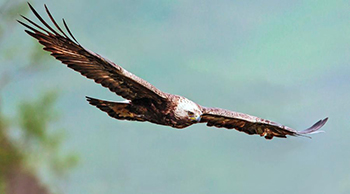
รอส ส์ อีวิง ผู้อํานวยการทุ่งของสก็อตแลนด์ แอนด์ เอสเตทส์ กล่าวว่า “บทบาทของนิคมเอกชนในการสนับสนุนโครงการ South of Scotland Golden Eagle มีความสําคัญในหลาย ๆ ด้าน รวมถึงการจัดหาลูกนกอินทรี 90% ที่ย้ายจากเหนือจรดใต้”

